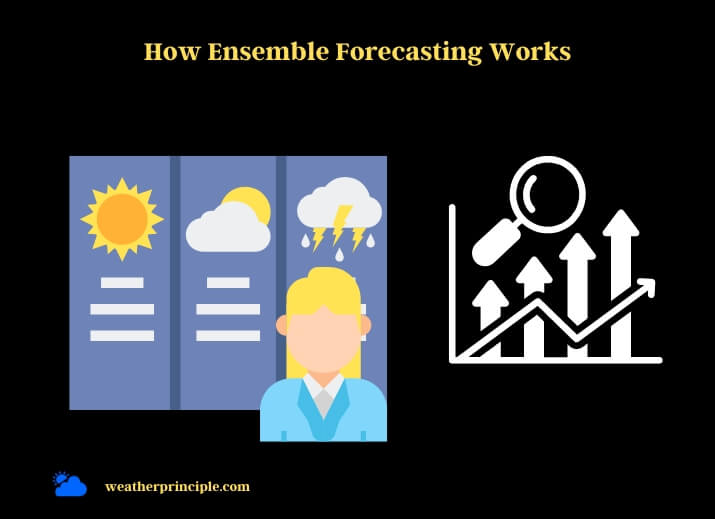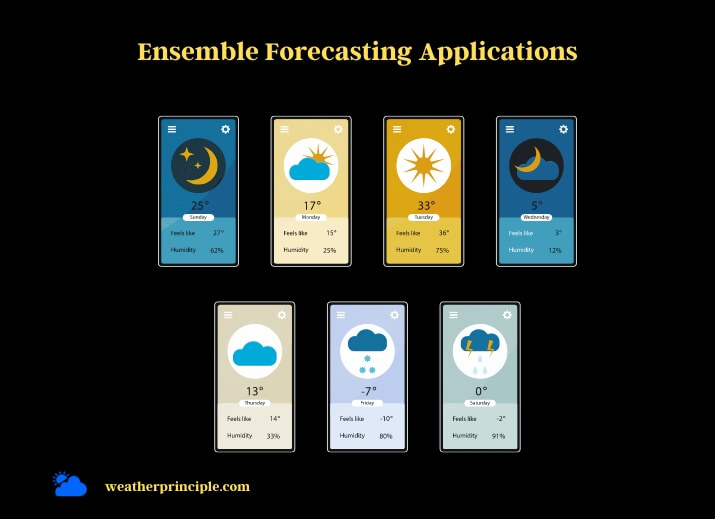Published on: May 11, 2023
Written by Kader Khan / Fact-checked by Shaown Khan
Weather forecasting has always captivated the minds of people throughout history. From ancient civilizations observing the sky to modern meteorologists using advanced technology, predicting the weather has evolved into a sophisticated blend of art and science.
Ensemble forecasting is a groundbreaking approach in weather prediction that has revolutionized the field of meteorology. By harnessing the power of probabilities and model diversity, ensemble forecasts provide more accurate and reliable predictions of weather events. This blog post will explore the ins and outs of ensemble forecasting, its applications, and its future potential.
Weather Forecasting: A Brief History
Ancient observations and early attempts
From the Babylonians using astrology to predict weather patterns to indigenous cultures interpreting cloud formations and animal behavior, weather forecasting has a long and varied history. The first systematic approaches to weather prediction emerged in the 19th century with the advent of the telegraph and the establishment of meteorological services.
Birth of modern meteorology: From 19th-century pioneers to WWII
The 20th century saw rapid advancements in weather forecasting, including the development of sophisticated observational networks, improved theoretical understanding of atmospheric processes, and the invention of the radio and radar. World War II accelerated the progress of meteorology, with both sides investing heavily in weather research and prediction.
The computer age: Numerical Weather Prediction (NWP)
The invention of the computer in the mid-20th century led to the development of Numerical Weather Prediction (NWP), which uses mathematical models to simulate the behavior of the atmosphere. NWP has since been the backbone of modern weather forecasting, paving the way for ensemble forecasting.
Ensemble Forecasting
The basics: What is ensemble forecasting?
Ensemble forecasting is an approach that generates multiple weather forecasts, called ensemble members, using different initial conditions or model configurations. By considering a range of possible scenarios, ensemble forecasts provide a more comprehensive understanding of the uncertainties associated with weather predictions.
The power of probabilities: Ensemble vs. deterministic forecasts
Unlike traditional deterministic forecasts that provide a single “best guess” prediction, ensemble forecasts use probabilities to express the likelihood of different weather outcomes. This probabilistic approach helps decision-makers assess the risks and uncertainties associated with weather events more effectively.
How Ensemble Forecasting Works
Initial conditions and model uncertainties
The atmosphere is a chaotic system, and small errors in initial conditions can result in significant differences in forecast outcomes. Ensemble forecasting addresses this issue by perturbing the initial conditions of the NWP model to generate a set of ensemble members that explore various possible scenarios.

Model diversity: Different models for different situations
Model diversity is another essential aspect of ensemble forecasting. By using multiple models or model configurations, ensemble forecasts can account for the inherent uncertainties associated with model assumptions, parameterizations, and resolutions.
Multi-model ensemble techniques
Multi-model ensembles combine forecasts from several independent models or modeling centers to create a more robust and accurate prediction. This approach capitalizes on the strengths of individual models while mitigating their weaknesses, leading to improved forecast skill.
Key Components of Ensemble Forecasting Systems
Data assimilation: Integrating observations and models
Data assimilation is the process of incorporating observations into NWP models to improve the accuracy of initial conditions. This step is crucial in ensemble forecasting, as better initial conditions lead to more reliable ensemble forecasts.
Perturbation methods: Exploring possible scenarios
Perturbation methods introduce small variations in the initial conditions or model parameters to generate ensemble members. These methods allow ensemble forecasting systems to explore a range of possible weather outcomes, providing a more comprehensive understanding of forecast uncertainties.
Post-processing and calibration: Refining ensemble predictions
After generating ensemble members, post-processing techniques are used to refine the forecasts and ensure they are statistically consistent with observed data. Calibration methods, such as bias correction and quantile mapping, improve the accuracy and reliability of ensemble forecasts by accounting for systematic model errors.
Ensemble Forecasting in Practice
Short-term forecasting: Weather in the next few days
Ensemble forecasting is widely used for short-term weather predictions, providing valuable information on the likelihood of rain, snow, temperature changes, and severe weather events. These forecasts help individuals and organizations plan daily activities, manage resources, and respond to hazardous conditions.
Medium-range forecasting: A week to a month ahead
Medium-range ensemble forecasts provide insights into weather patterns up to a month in advance. These forecasts are useful for various sectors, including agriculture, energy, and water management, allowing stakeholders to make informed decisions based on probable weather conditions.
Seasonal and sub-seasonal forecasting: Beyond a month
Ensemble forecasting also plays a critical role in predicting climate anomalies and seasonal variations, such as El Niño and La Niña events. These forecasts help governments, businesses, and communities prepare for potential impacts on agriculture, water resources, and public health.
Ensemble Forecasting Applications
Severe weather events: Tornadoes, hurricanes, and storms
Ensemble forecasting is instrumental in predicting and monitoring severe weather events, such as tornadoes, hurricanes, and storms. By providing probabilistic information on the location, intensity, and timing of these events, ensemble forecasts enable emergency managers and first responders to prepare and respond more effectively.

Climate risk management: Agriculture, water resources, and energy
Ensemble forecasts support climate risk management by informing decision-making in sectors such as agriculture, water resources, and energy. Probabilistic forecasts enable stakeholders to assess the risks associated with extreme weather events and develop contingency plans to minimize potential impacts.
Disaster preparedness and response: Saving lives and property
Ensemble forecasting plays a vital role in disaster preparedness and response, helping authorities to anticipate and mitigate the impacts of extreme weather events on human life and property. By providing timely and reliable information, ensemble forecasts contribute to building resilience and reducing the costs associated with natural disasters.
Advancements in Ensemble Forecasting
Artificial Intelligence (AI) and machine learning in ensemble prediction
AI and machine learning techniques are increasingly being applied to ensemble forecasting, improving model performance and post-processing methods. These advancements have the potential to further enhance the accuracy and reliability of ensemble predictions, benefiting various weather-sensitive sectors.
Improved modeling: Atmosphere-ocean coupling and Earth system models
Recent developments in atmosphere-ocean coupling and Earth system models have led to more sophisticated ensemble forecasting systems. By accounting for interactions between the atmosphere, oceans, land, and biosphere, these models provide a more comprehensive understanding of the Earth’s climate system and its response to natural and human-induced changes.
Enhanced observations: Remote sensing and high-resolution data
The availability of high-resolution observations from remote sensing platforms, such as satellites and ground-based instruments, has significantly improved the quality of input data for ensemble forecasting systems. These advancements enable more accurate representation of initial conditions and model parameters, resulting in better forecast outcomes.
Challenges and Limitations of Ensemble Forecasting
Model biases and limitations
Despite advancements in modeling techniques, ensemble forecasting systems still face challenges related to model biases and limitations. Addressing these issues requires continuous research, model development, and evaluation to improve the overall accuracy and reliability of ensemble predictions.
Computational constraints and resources
Ensemble forecasting requires significant computational resources, as it involves running multiple simulations with varying initial conditions and model configurations. Balancing the need for high-resolution models with the available computational resources remains an ongoing challenge in the field.
Balancing accuracy and uncertainty
Ensemble forecasting aims to provide accurate and reliable predictions while accounting for uncertainties in the weather system. Striking the right balance between these two objectives is essential to ensure that ensemble forecasts are useful for decision-making and risk management.
The Future of Ensemble Forecasting
Predicting extreme events and climate change impacts
As the impacts of climate change become more pronounced, ensemble forecasting will play an increasingly important role in predicting extreme weather events and their potential consequences. This information will be critical for informing adaptation and mitigation strategies in the face of a changing climate.
Global cooperation and data sharing
Enhancing the accuracy and reliability of ensemble forecasts requires collaboration among researchers, meteorological services, and modeling centers worldwide. Sharing data, models, and expertise will promote the development of better ensemble forecasting systems and improve the overall understanding of weather and climate phenomena.
Increasing public awareness and understanding
To maximize the benefits of ensemble forecasting, it is crucial to improve public awareness and understanding of probabilistic weather predictions. Efforts to communicate ensemble forecasts effectively and engage with various stakeholders will ensure that this valuable information is used to its full potential in decision-making and risk management.
How Can Ensemble Forecasting Help Me Dress Smart for Today’s Weather?
Ensemble forecasting provides a valuable tool for weather predictions, which in turn aids smart dressing. By combining multiple models, it offers a more accurate outlook, helping you decide what to wear. So, make the most of smart dressing tips to stay stylish and prepared, regardless of the ever-changing weather conditions.
Summary
Ensemble forecasting is a powerful tool in weather prediction that has transformed the field of meteorology. By incorporating multiple simulations and probabilities, ensemble forecasts provide more accurate and reliable predictions of weather events. This blog post has explored the history, methodology, applications, and future potential of ensemble forecasting, highlighting its importance in managing climate risks, predicting extreme events, and guiding decision-making across various sectors.



